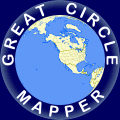Featured Map for 1 February 2020:
First ETOPS-120 Revenue Flight
35 years ago, on 1 February 1985, TWA flight 810 departed Boston for Paris on the first reveue flight operated under 120-minute ETOPS (ETOPS-120) rules using a Boeing 767-200 upgraded to ETOPS standards, a milestone which led to the use of twin-engine jetliners on nearly all long-distance flights today. The fuel burn on TWA 810 was 7,000 lbs per hour less than that of a Lockheed L-1011 TriStar flying the same mission, leading TWA to spend $2.6 million per aircraft to retrofit each of their 767-200s to meet ETOPS-120 requirements.
El Al had been flying the 767-200 trans-Atlantic between Tel Aviv and Montréal for nearly ten months but not under ETOPS rules, requiring a longer routing so as to stay within 60 minutes of a suitable alternate airport. Prior to that, Airbus A300 operators had been flying that first widebody twin-jet across the North Atlantic, the Bay of Bengal, and the Indian Ocean since 1976 under ICAO rules for 90-minute ETOPS.
Today's Featured Map shows the great-circle path from Boston to Paris (winds aloft may have led to a different path) plus ranges at single-engine speeds for 120 minutes from diversion airports at Gander and Reykjavík plus, in green, possible mid-Atlantic alternates at either Kangerlussuaq (Sondre Strømfjord) to the north and Terceira (Azores) to the south.
Also shown—as shaded areas—are range contours without shading for non-ETOPS (no more than 60 minutes engine-out flying time), light shading for ETOPS-90, darker shading for ETOPS-120, and the darkest shading for two areas beyond 120-minutes flying time on a single engine, including a small triangle northwest of the Azores and a much larger area southwest of the Azores (too far south to have been relevant to TWA 810.
References and additional information:
- The Boeing 767 and the Birth of Twin Engine Flying Over The Atlantic — How ETOPS Happened – Avgeekery.com (2 January 2016)
- Getting To Grips With ETOPS – Airbus (October 1998)
- Engines Turn or Passengers Swim: A Case Study of How ETOPS Improved Safety and Economics in Aviation
- Optimized Engine-Out Procedures to Extend the Range of Jet Transport Airplanes – Embry-Riddle Aeronautical University (ERAU) (1990)
- Trans World Airlines (TWA) Fleet Details and History – Planespotters.net
|
Information on this site may not be accurate or current and is not valid for flight planning or navigation. No warranty of fitness for any purpose is made or implied. Flight planning and navigation should only be done using official charts.
Copyright © 2010-2024
Karl L. Swartz.
All rights reserved.
|
